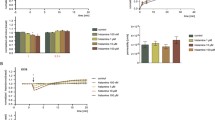Abstract
The endothelium is a thin layer of squamous cells that acts as a semipermeable barrier regulating vascular permeability to let molecules pass through it thereby maintaining tissue fluid homeostasis. Physiological increase in endothelial or vascular permeability is transient, transpired by post-tissue injury during the initial phases of healing, whereas pathological permeability is persistent commonly witnessed in conditions such as atherosclerosis, chronic inflammation, tumor growth, and diabetic retinopathy. The in vivo or in situ use of animal models in the assessment of permeability not only raises inevitable ethical concerns but also confers difficulty to apply to high-throughput screening. Therefore, there is an ever-increasing dependency on in vitro studies to assess drug permeability, and various research programs have suffered to develop appropriate in vitro assays for measurement and prediction. In vitro models that both mimic in vivo microvascular endothelium and can be utilized to record changes in endothelial permeability are vital in delineating the mechanisms involved in the prevention and treatment of disorders related to vascular permeability. The Transwell® and the electric cell-substrate impedance sensing (ECIS) assays are extensively used to assess the trans-endothelial permeability of solutes such as albumin, dextrans, and sucrose across endothelial monolayers and based on electrical resistance, etc. These models have several advantages such as the ease to perform and avoid the complexities of using a live animal.
Access this chapter
Tax calculation will be finalised at checkout
Purchases are for personal use only
Similar content being viewed by others
References
Pauty J, Usuba R, Takahashi H et al (2017) A vascular permeability assay using an in vitro human microvessel model mimicking the inflammatory condition. Nano 1(1):103–113
Tang X, Di X, Liu Y (2017) Protective effects of donepezil against endothelial permeability. Eur J Pharmacol 811:60–65
Benelhaj NE, Maraveyas A, Featherby S, Collier MEW, Johnson MJ, Ettelaie C (2019) Alteration in endothelial permeability occurs in response to the activation of PAR2 by factor Xa but not directly by the TF-factor VIIa complex. Thromb Res 175:13–20
Di A, Mehta D, Malik AB (2016) ROS-activated calcium signaling mechanisms regulating endothelial barrier function. Cell Calcium 60(3):163–171
Park-Windhol C, D’Amore PA (2016) Disorders of vascular permeability. Annu Rev Pathol 11:251–281
Martins-Green M, Petreaca M, Yao M (2008) An assay system for in vitro detection of permeability in human "endothelium". Methods Enzymol 443:137–153
Navarro P, Caveda L, Breviario F, Mândoteanu I, Lampugnani MG, Dejana E (1995) Catenin-dependent and -independent functions of vascular endothelial cadherin. J Biol Chem 270(52):30965–30972
Gao F, Alwhaibi A, Artham S, Verma A, Somanath PR (2018) Endothelial Akt1 loss promotes prostate cancer metastasis via β-catenin-regulated tight-junction protein turnover. Br J Cancer 118(11):1464–1475. https://doi.org/10.1038/s41416-018-0110-1
Gao F, Artham S, Sabbineni H et al (2016) Akt1 promotes stimuli-induced endothelial-barrier protection through FoxO-mediated tight-junction protein turnover. Cell Mol Life Sci 73(20):3917–3933
Alwhaibi A, Verma A, Adil MS, Somanath PR (2019) The unconventional role of Akt1 in the advanced cancers and in diabetes-promoted carcinogenesis. Pharmacol Res 145:104270
Artham S, Verma A, Alwhaibi A et al (2020) Delayed Akt suppression in the lipopolysaccharide-induced acute lung injury promotes resolution that is associated with enhanced effector regulatory T-cells. Am J Physiol Lung Cell Mol Physiol 318(4):L750–L761
Lee JB, Son SH, Park MC et al (2015) A novel in vitro permeability assay using a three-dimensional cell culture system. J Biotechnol 205:93–100
Islam S, Flaherty P (2018) Assay methods protocol: cell invasion assay. Corning Incorporated, Life Sciences Tewksbury, MA USA
Bischoff I, Hornburger MC, Mayer BA, Beyerle A, Wegener J, Fürst R (2016) Pitfalls in assessing microvascular endothelial barrier function: impedance-based devices versus the classic macromolecular tracer assay. Sci Rep 6:23671
Wegener J (2019) Measuring the permeability of endothelial cell monolayers: teaching new tricks to an old dog. Biophys J 116(8):1377–1379
Millipore (2010) In vitro vascular permeability assay (24-well) catalog no. ECM644. Revision A
Robilliard LD, Kho DT, Johnson RH, Anchan A, O'Carroll SJ, Graham ES (2018) The importance of multifrequency impedance sensing of endothelial barrier formation using ECIS Technology for the Generation of a strong and durable Paracellular barrier. Biosensors (Basel) 8(3):64
Chiu SP, Lee YW, Wu LY et al (2019) Application of ECIS to assess FCCP-induced changes of MSC micromotion and wound healing migration. Sensors (Basel) 19(14):3210
Yang JM, Chen SW, Yang JH, Hsu CC, Wang JS (2016) A quantitative cell modeling and wound-healing analysis based on the electric cell-substrate impedance sensing (ECIS) method. Comput Biol Med 69:134–143
Rahman AR, Lo CM, Bhansali S (2009) A detailed model for high-frequency impedance characterization of ovarian cancer epithelial cell layer using ECIS electrodes. IEEE Trans Biomed Eng 56(2):485–492
ECIS User Handbook (2018) Applied BioPhysics, Inc., vol 18, pp 1–16
Electric cell-substrate impedance sensing. Applied BioPhysics Operation Manual for all ECIS Systems Version 1.2.123:1–86
Acknowledgments
Funds were provided by the NHLBI grant R01HL103952, NCATS grant UL1TR002378, Wilson Pharmacy Foundation (intramural), and Translational Research Initiative grant (intramural) to PRS.
Author information
Authors and Affiliations
Corresponding author
Editor information
Editors and Affiliations
Rights and permissions
Copyright information
© 2020 Springer Science+Business Media New York
About this protocol
Cite this protocol
Adil, M.S., Somanath, P.R. (2020). Endothelial Permeability Assays In Vitro. In: Turksen, K. (eds) Permeability Barrier. Methods in Molecular Biology, vol 2367. Humana, New York, NY. https://doi.org/10.1007/7651_2020_309
Download citation
DOI: https://doi.org/10.1007/7651_2020_309
Published:
Publisher Name: Humana, New York, NY
Print ISBN: 978-1-0716-1672-7
Online ISBN: 978-1-0716-1673-4
eBook Packages: Springer Protocols




